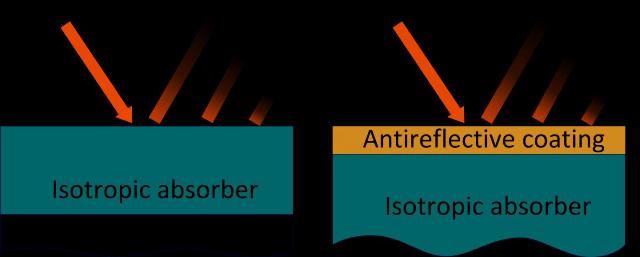Jan 19 2016
Researchers from the U.S. Naval Research Laboratory, MIPT, and Kansas State University have established a new method to absorb electromagnetic radiation, using a specific absorbing system like an anisotropic crystal. The study holds immense potential for electrodynamics and could offer a new way to absorb the electromagnetic wave energy. The results of the study have been reported in Physical Review B.
 On the left is an absorbing medium lying on a reflective substrate. On the right is an absorbing medium with an anti-reflective coating applied on top. In both cases the interference of light results in the complete absorption of energy within the artificial structure. (CREDIT: Image courtesy of the authors of the study)
On the left is an absorbing medium lying on a reflective substrate. On the right is an absorbing medium with an anti-reflective coating applied on top. In both cases the interference of light results in the complete absorption of energy within the artificial structure. (CREDIT: Image courtesy of the authors of the study)
In many practical applications - including photodynamic therapy, nanochemistry and sensing - there is a requirement to fully absorb the energy of electromagnetic radiation. Harvesting of electromagnetic energy in the visible spectrum is integral for photovoltaics, which converts solar energy into electric current. Absorbing materials in the microwave range of frequencies have the ability to reduce an aircraft’s radar visibility factor.
Black paint is one example of an electromagnetic absorber. The paint appears to be black as its layer absorbs most of the light that falls on it, preventing this light from reaching the observer. Although black paint does not fully absorb the light, and some of the energy emitted from the incident light is reflected into the surrounding area. The use of interference will aid in the complete absorption of the incident radiation.
An absorbing material layer is positioned on a reflective substrate or is integrated with a customized anti-reflective coating. The laws of electrodynamics state that a series of waves emerges, exhibiting varied phases and amplitudes that are reflected from the structure. This sequence of reflections is also apparent in a typical soap film. Reflected light of a specific color - depending on the film’s thickness - is observed when white light falls upon the film. In a similar way, when light falls on an absorbing system, the waves that are reflected cancel each other out. This creates a perfect absorption, as the radiation that is reflected disappears entirely. This phenomenon occurs if the parameters of the coating have been selected appropriately.
This kind of interference is referred to as destructive interference. In such systems, absorption tends to be sensitive to the structure’s geometry. Even a small variation in the layers refractive indices or thickness will result in incomplete absorption and reflected radiation reappears.
The group of scientists from the US and Russia demonstrated that a perfect absorption can be achieved without the need for destructive interference. The team utilized a specific absorbing medium – an anisotropic crystal, a hexagonal boron nitride. This medium is part of the van der Waals class of crystals, containing layers of atoms joined together through van der Waals forces from adjacent layers. These forces are evident between electrically neutral molecules and atoms, which also exhibit a dipole moment, i.e., their charges are not evenly distributed. As a result of the lattice arrangement, the crystal’s dielectric permittivity significantly varies for the in- and out-of-plane directions. In other words, the crystal turns anisotropic and a single number does not describe it, it is defined by a matrix of numbers called tensor. It is this dielectric permittivity tensor that establishes how light is reflected from the substance’s surface.
A crystal lattice possesses unique properties. As a result, hexagonal boron nitride is already being used in the field of nanoelectronics and optics. In this context, electromagnetic waves are fully absorbed thanks to the intense anisotropy of dielectric permittivity. When incident infrared radiation at a specific wavelength penetrates the crystal, it is fully absorbed within the medium without any reflections. This eliminates the need for anti-reflective substrates or layers to create destructive interference. Unlike in an isotropic absorbing medium, reflected radiation does not take place.
The ability to fully absorb electromagnetic radiation is one of the key areas of focus in electrodynamics. It is believed that destructive interference is needed to do this, which therefore requires the use of anti-reflective coatings, substrates and other structures. Our observations indicate that interference is not a compulsory requirement and perfect absorption can be achieved using simpler systems.
Denis Baranov, Corresponding Author
In order to view the expected phenomenon, an optically thick sample of hexagonal boron nitride was grown and the reflectance spectrum in the mid-infrared range was determined. At the analytically predicted angles of incidence and wavelengths, the researchers observed that the reflected signal dropped considerably – well below 10-4 of the incident energy reflected from the system. This means, the anisotropic crystal absorbed over 99.99% of the incident wave energy.
A major drawback of the proposed method is that perfect absorption can only be obtained for a fixed angle of incidence and wavelength, which in turn are established by the material’s electronic properties. When it comes to practical applications, energy absorption could be useful in a range of wavelengths and angles of incidence. These limitations can be resolved in the future with the aid of biaxial absorbing media and other strongly anisotropic materials, providing more flexibility to the newly proposed method.
From a fundamental aspect, this experiment demonstrates that it is possible to fully absorb electromagnetic radiation without the need for destructive interference. The effect provides an innovative way to regulate electromagnetic absorption. As such, the use of anisotropic crystals could enable the development of next-generation sensors and absorbing devices that function in the IR range.